Haunted by the Zeitgeist
Why is it that we can talk at length about the personal, psychological, formal and material qualities of art, smartly discuss art historical and pop cultural reference points – but not "the political"?

“The leaves are falling, falling as from far
Rainer Maria Rilke, “Herbst,” 1902
as if distant gardens wilted in the skies;
They are falling with a gesture that denies”
[author’s translation]
“There is a fall coming.”
Paul Kingsnorth and Dougald Hine.
Uncivilization. The Dark Mountain Manifesto, 2013.
A recent public conversation with Michael Kareken, occasioned by his twin exhibitions at the Burnet and Groveland galleries, ranged far and wide: from art history to David Cronenberg’s Crash, anecdotes from the scrap yard and the psychology of monstrous machines. Minneapolis Institute of Arts’ Christopher Atkins deftly steered the conversation to leave no angle of Kareken’s work unexplored. A question from the audience speculated on reading Kareken’s gorgeous paintings of car wrecks, collectively titled Parts, as a metaphor for the ruined mythos of the car, an icon of American culture. Are the engines Kareken photographs, draws, paints, and collages broken just like the promise of freedom, autonomy, mobility, and unfettered individualism car culture seemed to offer? The artist was quick to skirt “the political” as a relevant register of engagement with his work.
But his reaction spurred my curiosity: Why is it that we can talk at length about the personal, psychological, formal and material qualities of art, explore the artist’s process and experiences in the scrap yard and the studio, smartly discuss art historical and pop cultural reference points–but not “the political”?
So, I asked this very question. Here is what I learned: “The political,” said Kareken, “makes the work one-dimensional.” Sitting in the back, I could see lots of heads in the audience nodding their agreement. In other words, the consensus that evening seemed to be that “the political” is powerful enough to trump all other avenues of engagement. In this view, such a lens reduces and distills all the intriguing conversations Kareken’s work entertains so well to just one bland message we may not want to hear. That’s ascribing a lot of power to “the political.”
What I continue to be intrigued by, days after the conversation has ended, is this perception of “the political” as potent enough to become a taboo that cannot be breached in the fine setting of a commercial gallery, even if the art in question clearly points to such far-reaching questions. Let me be clear that I am less interested in the perceived marketability of “the political” in art here and much more in the question of why “the political” is said to overshadow everything else. Does reference to the realm of “the political” truly hamper art’s ability to provide meaningful aesthetic experiences–or meaningful occasions for socializing and networking, as Lane Relyea observes? What exactly does it mean to embrace or elude “the political,” and what does that contested concept mean in the context of art and aesthetics?

ITo explore these questions, let’s consider Michael Sailstorfer’s It Might As Well Be Spring, a solo exhibition curated by Kris Douglas on view at the Rochester Art Center (RAC) until February 2015, as a point of comparison. Sailstorfer’s work may still be familiar to Twin Cities audiences from 2009, when Peter Eleey included a video and two sculptures by the artist in The Quick and the Dead at the Walker Art Center. In Zeit ist keine Autobahn, Berlin (Time Is No Highway, Berlin), a black truck tire spins against a gallery wall. The friction slowly melts the rubber. Loud, stinky, mundane–and the bane of many a gallery attendant on duty during The Quick and the Dead–the installation, deprived of any movement beyond its futile rotations, was curiously, oddly, poetic.
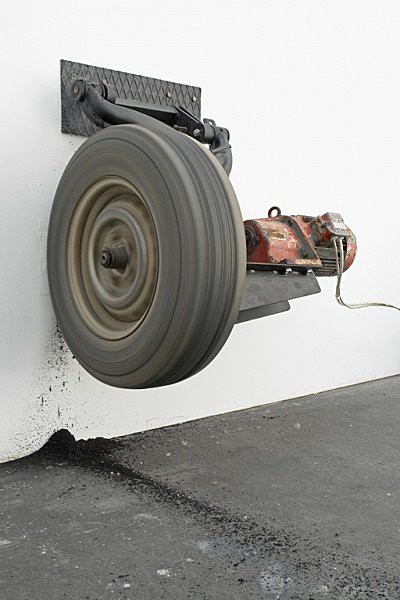
Like Kareken, Sailstorfer is interested in cars, although the artists’ material languages could not be more different. Kareken paints, while Sailstorfer’s work extends across a range of mediums: photographs, videos, sculpture, and installations that often unfold and change over time. Rather than represent everyday objects as Kareken has been doing in past bodies of work, Sailstorfer incorporates quotidian materials directly and activates them in often unexpected ways. Zeit ist keine Autobahn is a case in point. The tire’s gradual degradation meditated on the allure of speed, the passing of time manifested in the growing pile of rubber shreds, resembling nothing so much than a contemporary version of a non-reversible sand clock.
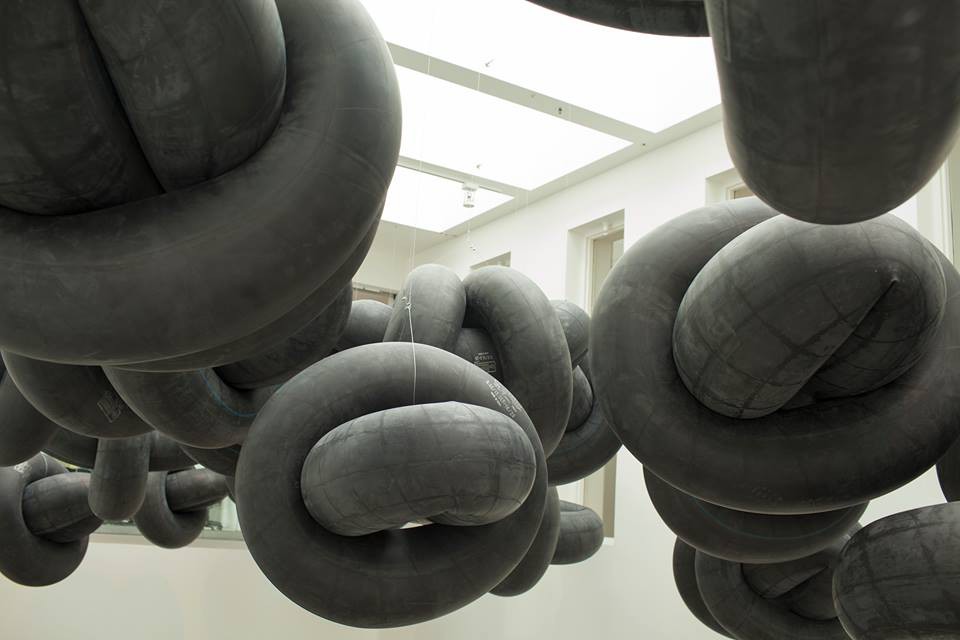
In It Might As Well Be Spring, Sailstorfer again re-purposes car parts: in Wolken (Clouds) (2014), suspended above the Rochester Art Center’s airy staircase, huge inner tubes, one stuffed inside another, form a bank of black clouds. Far removed from their automotive context, the tubes are not devoid of humor: despite their ominous color, the bulging shapes are so twisted, so oddly corporeal, so cartoonish and fun to look at, that they become strangely endearing. In a similar gesture, Sailstorfer transforms an entire Rochester police car into a drum set for Schlagzeug, Rochester (Drumkit, Rochester) (2014).
Interested in activating the potentiality of his material, Sailstorfer transforms and estranges the ordinary in work that borders ekphrasis: Dave (2014) makes sound visible. Sailstorfer dissects a drum solo by Slayer legend Dave Lombardo into its various acoustic components, isolating each cymbal and drum to one dedicated speaker. A plain cardboard box covers each speaker. Moving between the boxes not only creates a spatial experience of sound but, in the vibrating cardboard walls, allows sound a visible presence outside the body. The cardboard boxes become resonance chambers, activated and moved by the sound waves. In 2008, working with a considerably bigger box shape, Sailstorfer first built and then exploded a sheet metal warehouse. He recorded the explosion, then digitally slowed and looped the moments leading up to the blast. The result, Untitled (Lohma), presents a warehouse that seems to breathe, shivering with the forces of the explosion to be, imbued with a strange animacy.
Kareken, too, is intrigued by the life, and afterlife, of machines. If, as Heidegger argued, we understand objects in terms of their relationship to us, their “equipmentality,” Kareken’s car parts, having lost their utility, become something else. Devoid of functionality, the wreckage takes on a different identity and becomes perceptible, for the first time, in its failure as an “object-in-itself.” Something alien and slightly monstrous arises from this transformation: a creaturely hybrid made of flesh-colored tubes and cable veins. Kareken references H.R. Giger, the artist responsible for Ridley Scott’s original Alien, and Mary Shelley’s Frankenstein, a creature collaged from cadaver parts who exceeds his maker’s designs. The car carcasses in Parts evoke a similar Gothic sensibility, a creature-like thing in the making, an alien form of vibrant matter.
Of course, we live in a time of strange hybrids: from plasticglomerate to dark ecologies, the irreversible and permanent entanglements of human-made substances and the geologic record have become a source of, at times, sublime fascination for scientists, scholars, and artists. In Kareken’s smaller-scale works on Mylar, where trees grow out of the automotive wreckage, the process of the ruined machines merging with other organisms to form a disconcerting-something-else becomes most explicit: a something-else that couldn’t care less about the human, rising from the overlooked and disavowed remnants of our prized way of life. A Gothic motif rears its head: whether the Id of psychoanalysis or cursed ghosts buried in family tombs, a rising, irrational force funnels the anxieties of an age. The recent resurgence of the Gothic is intimately connected to the rise of the Anthropocene, the age when humans have become a force affecting the planet’s fate. Kareken’s paintings, drawings and collages capture this somber zeitgeist, a German loan word that denotes the intangible ghost of an age, haunting us with an ephemeral presence. His formal compositions often spiral inward, around a dark center, as if to suggest a vortex from which there is no escape.
Kareken describes his process as deeply intuitive, not unlike Sailstorfer, who is quoted in RAC’s exhibition brochure as explaining, “you can compare what I am doing to writing a song. You take what surrounds you and bothers you and put it in a song …. [it] sounds super romantic but that’s what makes me do things.” Based on the work assembled in It Might As Well Be Spring, Sailstorfer has been surrounded and bothered by an anxiety symptomatic of our day and age: Will we wait to appreciate the ecosystems we are part of until they, like Kareken’s wrecked cars, have been ruined, and in failing become “objects-in-themselves,” are no longer masked in purpose?

Sailstorfer broaches this manifestation of the zeitgeist in a number of installations. In Forst (Forest) (2010), five trees, suspended upside-down from rotating mechanical arms, slowly sweep across the gallery floor in circular rotations. As the trees dry and die, more leaves fall. A circle of fallen foliage surrounds each tree. As the installation ages, the leaves will slowly turn to dust. Their smell, plant matter on the verge of decay and rot, fills the space. The gallery is alive with the whispers of rustling leaves and the clicks and creaks of machinery, as Sailstorfer’s arboreal dance macabre unfolds. In Anti-Herbst (Anti-Fall) (2012-2013), the artist presents a series of roughly 30-second shots of an old elm tree in a meadow. A small German country road passes the tree, and a bench rests in its shadow–a pastoral idyll. At first, it seems we will witness the tree’s change through the seasons. From blazing, sun-streamed yellow, we move to patches of rust and bare limbs; the light, too, changes from slanted late summer rays to foggy fall days; sheep come and go. But although Anti–Herbst captures the elm in fall, that most melancholy of seasons that has inspired countless German and Austrian poets (from Rilke to Bachmann, Lasker Schueler to Borchers), Sailstorfer’s magnificent elm tree is arrested in fall: Anti-Herbst shows us a tree, not in transition, but in perennial decline, a fall without end.
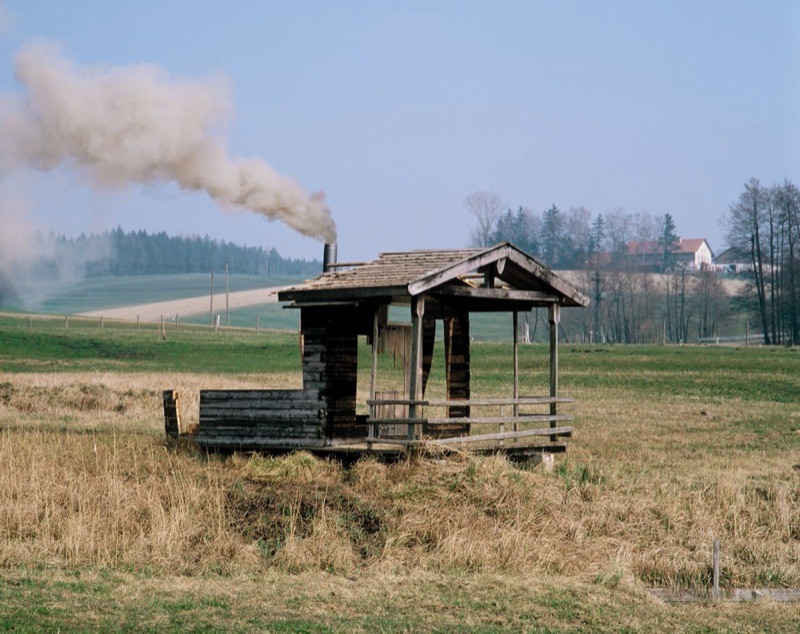
3 Ster mit Aussicht (2002), a video loop composed of brief, fixed-camera shots, begins in another rural idyll: a rustic cabin in a morning fog-filled pasture. A thin column of smoke begins to rise from the chimney. In the next shot, a slight change occurs. As if we were looking at the proverbial gingerbread house, a bite-shaped piece of cabin disappears, followed by more and more missing chunks. Gradually, the cabin is reduced to a skeleton that reveals an old-fashioned wood stove, the hearth, merrily churning out heat and smoke. An understanding dawns: the stove is consuming the cabin. The cost of comfort and warmth is the very shelter the cabin provided. The video ends in darkness, with only sparks from the stove lighting up the night.
Sailstorfer’s visual poetics tap into a number of allegorical narratives in 3 Ster mit Aussicht, a title truncated into a strange German-English hybrid (3 star with view), grammatically incorrect in both languages. Does the video speak to consuming resources unsustainably for short-term benefit? Does it allude to the reckless deforestation of Europe in the 17th century? Then, wood was cut down to make coal, to produce steel at a time that proved to be the onset of the industrial revolution – which leads us straight to the Anthropocene. Sailstorfer leaves us in the dark, but these histories and allegories cannot help but haunt his work.
As in Kareken’s paintings, the melancholic, haunted quality of Sailstorfer’s work conjures a Gothic sensibility, deeply skeptical of narratives of progress and innovation. What darkness do those uplifting narratives of telos and purpose repress? What will come back, like Freud’s uncanny, to haunt us? Both Kareken’s and Sailstorfer’s works suggest alternative narratives, fictions that begin after the faith in congratulatory stories of uplift and enlightenment have dimmed and dulled. Sailstorfer’s Untitled (No Light) (2010) offers a final laconic statement, a pitch-perfect icon of anti-enlightenment: a black light bulb, cast in plastic polyurethane, sadly wilts on its stem, a sad, drooping little thing utterly unable to illuminate anything.
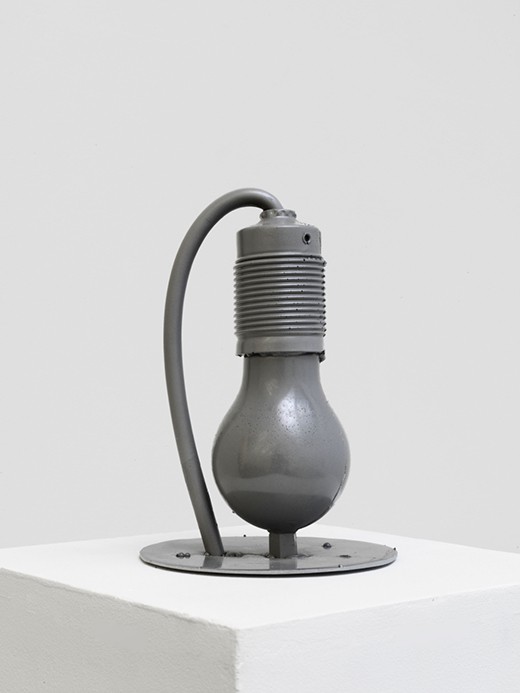
Both artists present compelling work, timely and engaged with the perplexing issues of our time. The question remains, is this work political? If so, in what sense? And what are the actual and perceived risks of embracing or eschewing “the political” it calls to mind?
Based on Kareken’s reaction to “the political,” the perceived risk clearly hinges on politics overshadowing aesthetics. That is, once we see the work as a commentary on car culture, a critique of our romance with fossil-fueled mobility, the paintings risk losing their complexity. Their beauty might be reduced to mere propaganda. Clearly, there is good reason to be wary of the intersection of aesthetics and politics. When it comes to the faith we hold in art’s ability to change the world, it may take a particular kind of idealism to still hold on to what Jacques Rancière describes, respectively, as the “pedagogical model” of art’s aesthetic efficacy and the “model of ethical immediacy.”1 I do not believe that Kareken’s or Sailstorfer’s work are political in the limited sense of these definitions.
But Kareken’s insistence of looking at the abandoned remains of the perhaps most fetishized American machine, followed by photographing, painting, and collaging said remains, does not strike me as insignificant: How can a gesture so invested in the detritus of car culture not signify, that is, how can it not bear meaning? Simply the act of directing our attention to the ruined parts conveys something, surely. Representing the wrecks in such luscious detail, such deliberate compositions, cannot be dismissed as mere intuitive happenstance. But what if we follow Kareken’s thinking and embrace art’s aesthetic separation from the mundane and murky world of environmental pollution and politics?
Rancière, in writing about aesthetic separation, notes that the idea does not entail “the constitution of a private paradise for amateurs and aesthetes. Instead, it implies that there can be no private paradise, that the works are torn away from their original destination, from any specific community, and that there is no longer any boundary separating what belongs to the realm of art and what belongs to the realm of everyday life.”2 In Rancière’s mind, such aesthetic separation is prerequisite for any political punch art may hope to deliver. In other words, art’s political efficacy arises precisely from the rupture of any determinate, determinable link between cause and effect. So while art can change what and how we think and perceive, can question what passes as common sense or simply ‘given’, “this political effect occurs under the condition of an original disjunction … which is the suspension of any direct relationship between cause and effect.”3
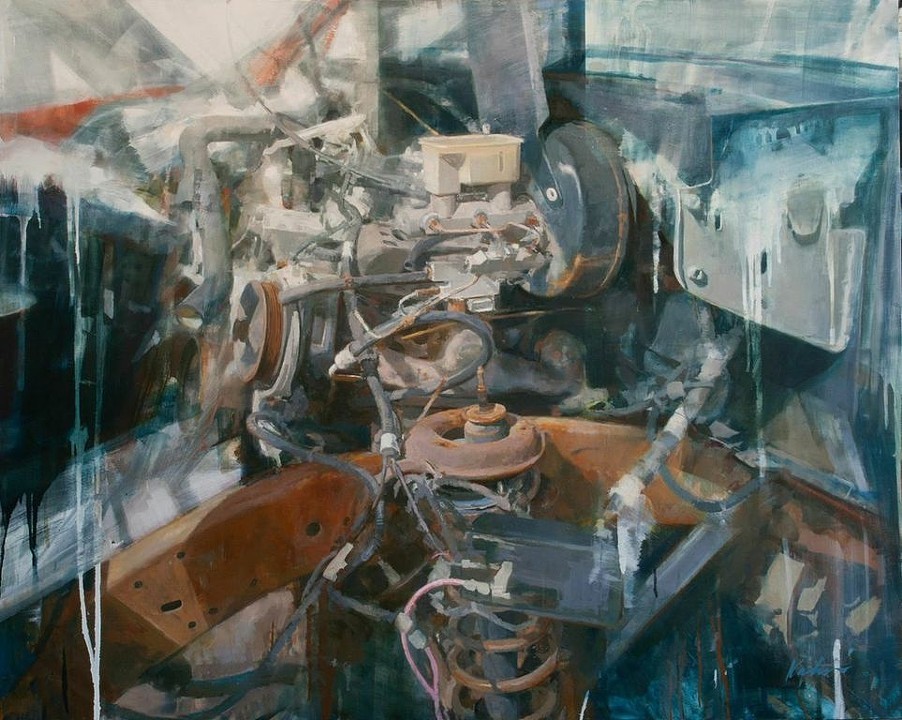
To change what Rancière calls the “cartography of the perceptible, thinkable, and the feasible,” art must maintain its distance, a withdrawal from any clearly defined political agenda. Only under the auspices of such aesthetic separation can art’s politics unfold, a politics which, in Rancière’s sense, has the potential to “reframe the given by inventing new ways of making sense of the sensible, new configurations between the visible and the invisible, and between the audible and inaudible, new distributions of space and time.”4 At times, it may even make the audible visible.
In the sense outlined by Rancière, Sailstorfer’s and Kareken’s practices share an affinity for a politics premised on aesthetic distance. Far from retreating to some illusion of a “private paradise,” their work is deeply involved in the issues of our time. Haunted by the zeitgeist, Kareken’s art pictures an aftermath. The paintings are indeed “inside looking in,” as Kareken explained in the conversation at Burnet gallery, as opposed to inside looking out or outside looking in. From deep within the belly of the beast, Kareken invites us to absorb all there is to see, all there is to learn about the great sputtering engine of myth-making, American-style.
Yet, faced with the perhaps necessary gesture of denial, even disavowal, it bears remembering that, Ranciere’s argument for aesthetic distance is but one way to draw a line between art and politics: other lines are possible, feasible, thinkable. Joseph Kosuth, for instance, avers that “politics … is not an abstract message that reduces the work to a passive purveyor of ‘content’-as illustration–but, on the contrary, is a socially-based activity which makes the viewer/reader part of the cultural act of completing the work” (94). Or, to quote another great maker of such lines, Francis Alÿs, “sometimes doing something poetic can become political and sometimes doing something political can become poetic.” Finally, Timothy Morton raises the question of whether we can continue to afford a Kantian “Goldilocks distance between you and the art object, not too close, not too far away.” When the picture frame is melting, extruding itself towards us, starting to burn our clothing–will we continue to hold on to proper aesthetic distance? 5
The lines between art and “the political” are as fluid as we make them. Where we draw them is as urgent as it’s ever been, a fact illustrated by A. O. Scott’s recent panel discussion in The New York Times. His first question for the participating artist panelists: Is it the responsibility of artists to address social issues, like race and class, in their work?
While there is and never will be consensus on the matter, asking the question remains vital if we want art to matter.
Related exhibition and information: Michael Kareken’s joint exhibition, Parts, at both Burnet Gallery and Groveland Gallery in Minneapolis, was on view from October 16 to November 29. Michael Sailstorfer: It Might As Well Be Spring is on view at the Rochester Art Center, Rochester, Minn. October 17, 2014 through February 15, 2015.